
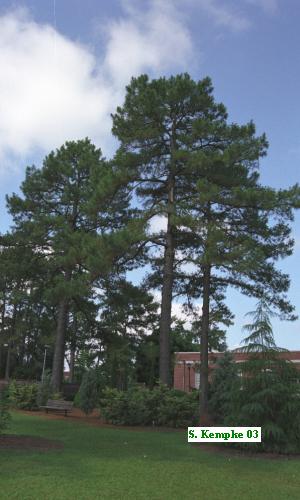 |
Our journey begins as we exit the back door (northwest) of the Science Center(5). We will be heading north towards the Jenkins Theatre (4) and eventually to the Administration Building. Along the way we will be passing a number of plants but only stopping to see and expound on some of them. Looking down the path, as shown in the photo on the left, we see a tall long leaf pine tree towering over the skyline of the path. Many more will be found throughout the campus. |
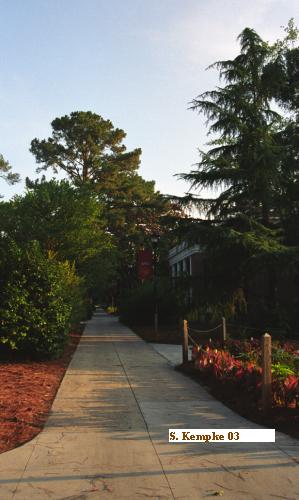 |
One of the first tall plants we see close by is located at the southwest corner of the Jenkins Theatre. It is a large, Live Oak tree, one of the most common trees on campus and the state tree of Georgia.
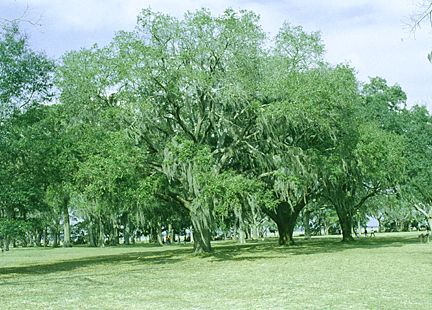
The Live Oak was recently featured in the monthly brochure of The National Arbor Day Foundation.
On a path to the right of the Live Oak are new plantings that include 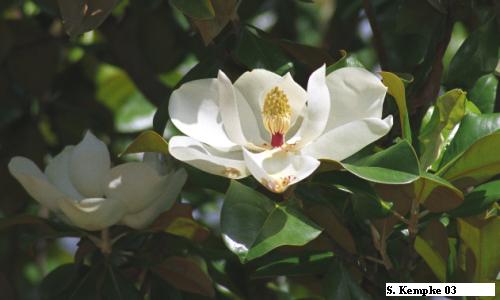 Magnolia, Magnolia,
the  Dawn Redwood and the Dawn Redwood and the
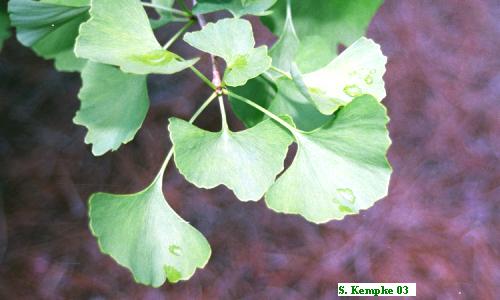 Ginko, (the Ginko is sometimes considered a living fossil since it was thought to be extinct. It was rediscovered in Asia and been planted throughtout this country including in the area of the capitol in Washington, D.C. Among its many unusual characteristics is its ability to withstand high levels of air pollution, making it an adaptable plants for large urban areas. It has both a male flower and tree and a female flower and tree. The female produces a fruit that produces a butrifying aroma similar to rancid butter. Even though it considered a Gymnosperm it loses it split shaped (bilobed) leaves in the late fall.) Ginko, (the Ginko is sometimes considered a living fossil since it was thought to be extinct. It was rediscovered in Asia and been planted throughtout this country including in the area of the capitol in Washington, D.C. Among its many unusual characteristics is its ability to withstand high levels of air pollution, making it an adaptable plants for large urban areas. It has both a male flower and tree and a female flower and tree. The female produces a fruit that produces a butrifying aroma similar to rancid butter. Even though it considered a Gymnosperm it loses it split shaped (bilobed) leaves in the late fall.)
All three of these trees can be found at other sites on campus but it is nice to have them all together right outside the Science Center back door. |
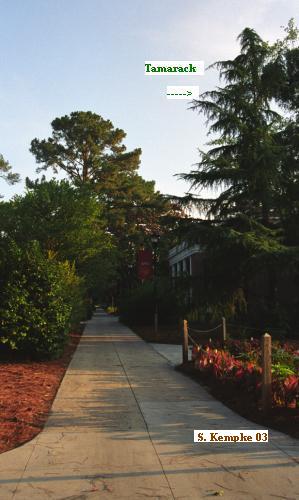
|
Next to the Live Oak, on its left, is an equally large tree known as the American Larch or Tamarack. Its scientific name is Larix laricina.
This tree is a Gymnosperm. The best known Gymnosperms are conifers - cone bearing plants with leaves modified into the form of needles. The Tamarack is unusual because it loses all of its needles during the winter season. Most conifers lose some needles every month but do not lose all of their needles at one time or season. The picture to the left identifies the position of the Tamarack relative to the other plants. The pictures below show an overview of the entire tree and a close-up of the needles. 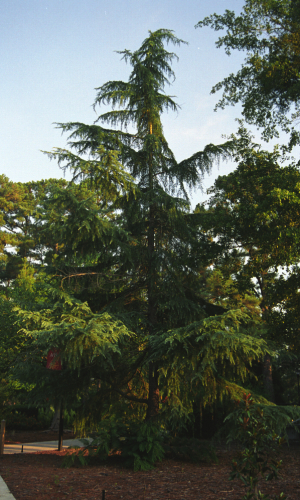 © S.Kempke03 © S.Kempke03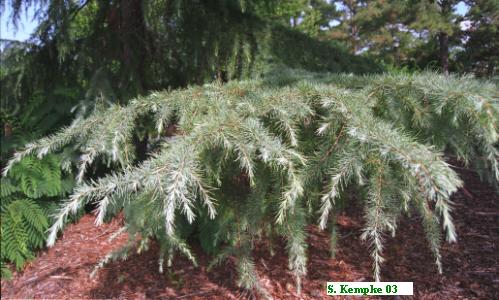 © S.Kempke03 © S.Kempke03
Flowers exist in profusion. Vivid rainbow colors are everywhere along the paths |
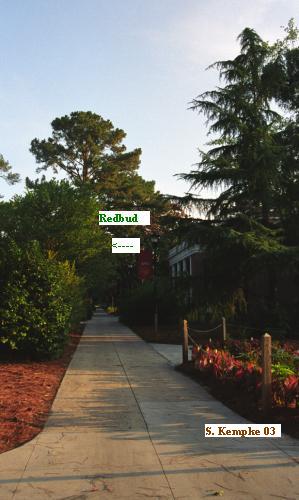

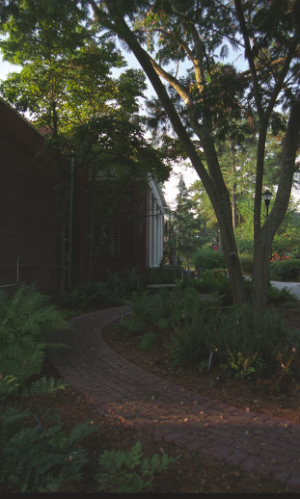 |
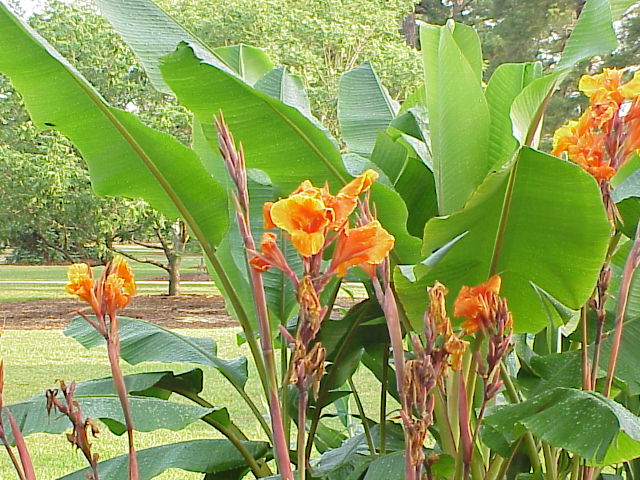 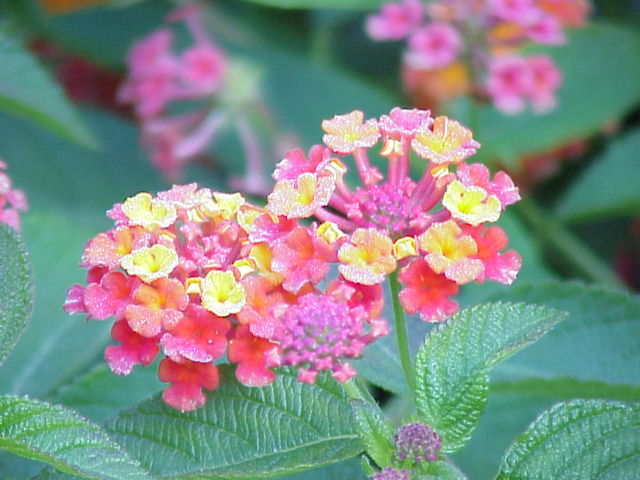
 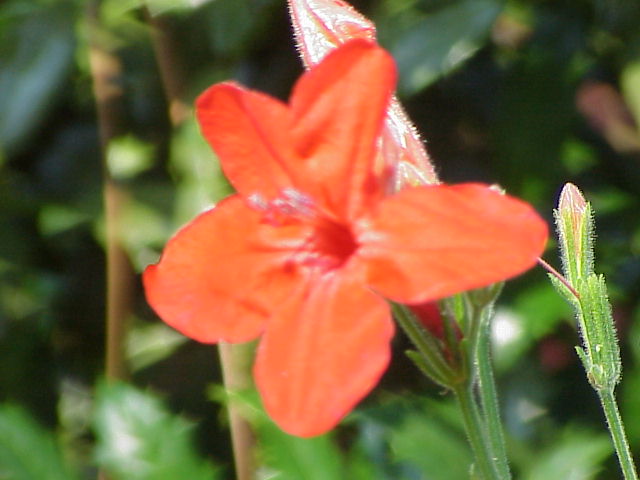
As we continue on the path we note a tree just opposite the front of Jenkins Theatre (4). This tree is shown in the photo on the left. It has heart-shaped leaves and we will find several of them along this path. This tree is the Redbud, scientific name Cercis canadensis. Legend suggests that Judas Iscariot hung himself on a relative of this tree so it is sometimes called the Judas tree. A fine shade tree, it is a harbinger of spring.
This tree is an example of an Angiosperm or flowering plant. It belongs to the same family as the bean and the pea. Its flowers produce seeds that are borne in pods. The Redbud contains bacteria in its root cells which allow the plant to convert the nitrogen in the atmosphere into usable forms of nitrogen within the plant. Plants which can "fix" nitrogen in this way are known as legumes. The pictures below show an overview of the entire tree and a close-up of the leaves.
 © S.Kempke03© S.Kempke03 © S.Kempke03© S.Kempke03
We continue past Jenkins. As we reach the north side we come to the Fern Garden (area shown in red outline). Nineteen (19) species are currently planted and more will be added. Information about the Fern Garden will be found by following this link.
In the middle of the Fern Garden is a large Mimosa or Silk Tree shown in the photo on the left. Its scientific name is Albizzia julibrissin.
The picture below shows the beautiful flower of the Mimosa.
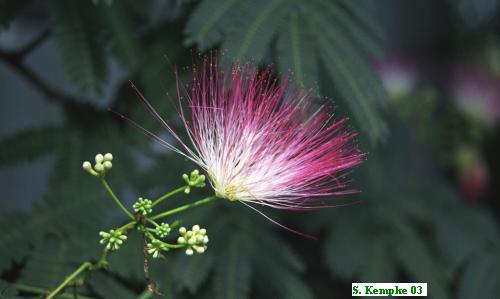 © S.Kempke03 © S.Kempke03
|
 |
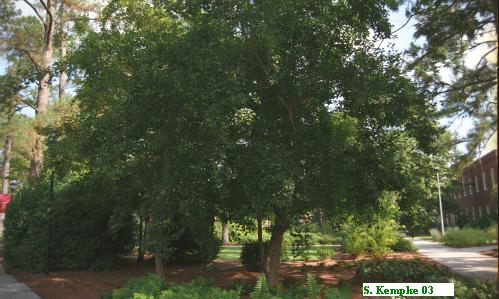
Just across from the Mimosa and the Fern Garden are a series of Trident Maple Trees. Maples are in the group of trees that have a opposite branching pattern that helps in identification of trees even without the leaves. Maples, Ashes, Dogwoods, Horse Chestnuts and members of the Caprifoliaceae all have opposite branching.
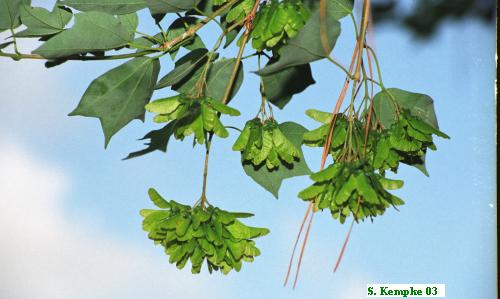
|
 | 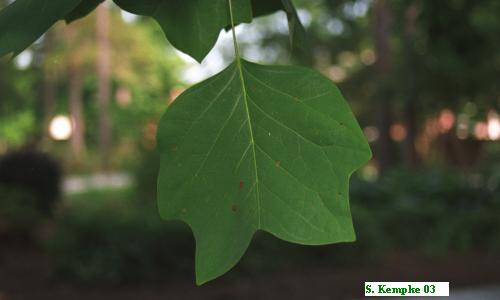
Just in front of Gamble Hall is a tree with an unusually shaped leaf. The Tulip tree (Liriodendron tulipifera) is found as far north as southern Canada.
|
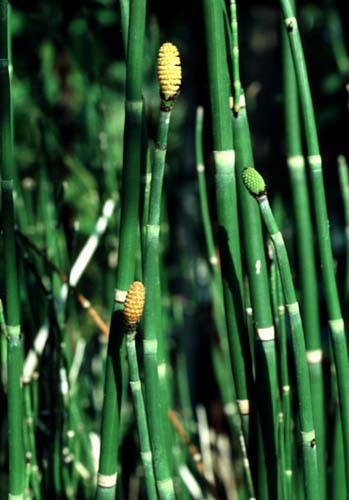 |
Just past Gamble Hall and just before the Conifer Garden located at the corner of the Administration Building will be found a group of simple plants called either Scouring Rushes or Horsetails. Their scientific name is Equisetum. Their cells walls are filled with silica that the plant absorbs from the soil. It gives the stem a rasplike feeling and is the reason for the plants name of scouring rush. It was used by our pioneer ancestors as the original "Brillo pad." |
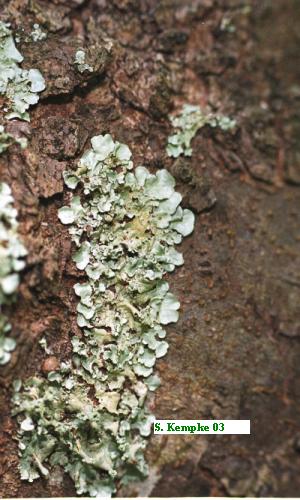 |
As you walk about the campus you will note a gray green growth on the bark of many trees. (Note the picture on the left) This same growth may be found on branches and pieces of stems that have fallen to the ground. This growth is that of a typical lichen. A lichen is an usual association between two organisms - a photosynthetic partner such as a photosynthetic algae or a photosynthetic bacterium and a fungal partner. These organisms are resistant to direct sunlight, drying out and are often found growing in many inhospitable areas.
Hanging from the branches of many of the trees around campus is a gray filamentous growth calledSpanish Moss. This plant is really an Angiosperm and forms a small pale yellow gold flower in the spring. This plant material was used by Henry Ford as cushion filling in his first cars. Unfortunately, much of the the Spanish Moss was collected off the ground where small red spider mites infiltrate the branches of the plant. Customers complained of severe itching from the seat cushions and the use of the moss was curtailed. Spanish Moss provides a ghostly visage on large Live Oak trees throughout Savannah - adding, undoubtedly, to many of the midnight ghost tours!
There is much still to be seen on campus and that will require another semester to identify online. Keep up to date by going to the Armstrong Atlantic State University Homepage. Follow the links to Academics, Colleges and Schools, Biology, On-line Walkabout. |
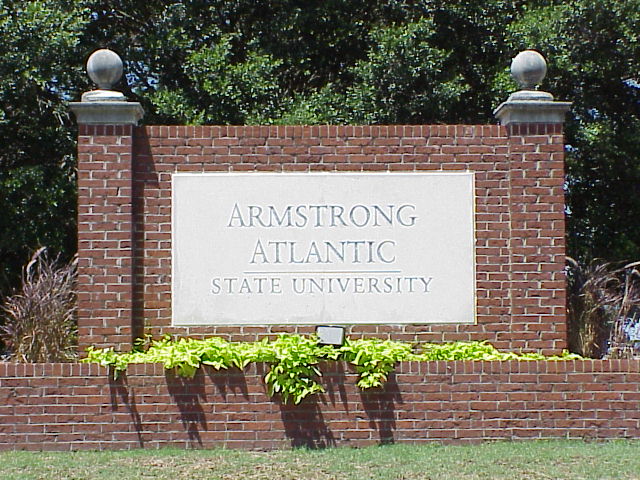

Magnolia,
 Dawn Redwood and the
Dawn Redwood and the Ginko, (the Ginko is sometimes considered a living fossil since it was thought to be extinct. It was rediscovered in Asia and been planted throughtout this country including in the area of the capitol in Washington, D.C. Among its many unusual characteristics is its ability to withstand high levels of air pollution, making it an adaptable plants for large urban areas. It has both a male flower and tree and a female flower and tree. The female produces a fruit that produces a butrifying aroma similar to rancid butter. Even though it considered a Gymnosperm it loses it split shaped (bilobed) leaves in the late fall.)





© S.Kempke03
 Dr. Ken Relyea, Chairman
Dr. Ken Relyea, Chairman
